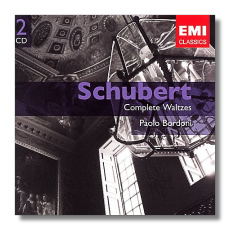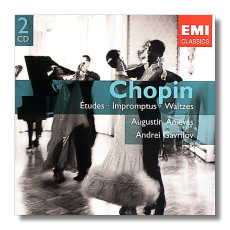
The Internet's Premier Classical Music Source
Related Links
-
Chopin Reviews
Schubert Reviews - Latest Reviews
- More Reviews
-
By Composer
-
Collections
DVD & Blu-ray
Books
Concert Reviews
Articles/Interviews
Software
Audio
Search Amazon
Recommended Links
Site News
 CD Review
CD Review
Waltzes

Franz Schubert
- 34 Valses sentimentales, D. 779 (Op. 50)
- 12 Valses nobles, D. 969 (Op. 77)
- 2 Scherzos, D. 593
- 36 Waltzes, D. 365 (Op. 9)
- 12 Waltzes, D. 145 (Op. 18)
- German Dance (Waltz) in C Sharp Major, D. 139
- Variations on a Waltz in C minor by Diabelli, D. 718
- Waltz in G Major "Albumblatt", D. 844
- Cotillon in E Flat Major, D. 976
- Waltz in A Flat Major, D. 978
- Waltz in G Major, D. 979
- 2 Waltzes, D. 980
- 20 Waltzes "Letzte Walzer", D. 146 (Op. 127)
- German Dance (Waltz) in E Major, D. 135
- Waltz in F Major "Letzte Walzer", D. 146/5b (Op. 127)
- 12 Waltzes "Grazer", D. 924 (Op. 91)
Paolo Bordoni, piano
EMI Classics 350894-2 ADD 2CDs: 73:49, 74:22


Frédéric Chopin
- Waltz "Grande valse brillante" in E Flat Major, Op. 18 (B 62)
- 3 Waltzes, Op. 34
- Waltz "Grande Valse" in A Flat Major, Op. 42 (B 131)
- Waltz in E Flat Major, (B 46)
- Waltz in A minor, (B 150)
- 3 Waltzes, Op. 64 (B 164)
- Waltz "Sostenuto" in E Flat Major, (B 133)
- 2 Waltzes, Op. 69
- Waltz in A Flat Major, (B 21)
- Waltz in E Major, (B 44)
- 3 Waltzes, Op. 70
- Waltz in E minor, (B 56)
- 12 études, Op. 15 1
- 12 études, Op. 25 1
- Trois Nouvelles études, (B 130) 2
- Impromptu #1 in A Flat Major, Op. 29 (B 110)
- Impromptu #2 in F Sharp Major, Op. 36 (B 129)
- Impromptu #3 in G Flat Major, Op. 51 (B 149)
- Impromptu #4 "Fantaisie-Impromptu" in C Sharp minor, Op. 66 (B 87)
- Cantabile in B Flat Major, (B 84) 3
- Contredanse in G Flat Major, (B 17) 3
- Berceuse, Op. 57 (B 154) 4
Agustin Anievas, piano
1 Andrei Gavrilov, piano
2 Danielle Laval, piano
3 Tzimon Barto, piano
4 Daniel Barenboim, piano
EMI Classics 350874-2 ADD/DDD 2CDs: 74:45, 76:19
These are two recent releases from EMI Classics' Gemini series, in which two discs are sold for the price of one mid-priced disc. (The moral of the story seems to be this: if you see an EMI Classics release that catches your eye, hang on, because it probably will be reissued three times in the next decade, at progressively lower prices!)
The Schubert set is kind of like going to a cocktail party where the hors d'oeuvres are so good that after having one, you have another. Then another. Still another… and so on, until you've made a meal out of hors d'oeuvres and you have no room left for your dinner. This purportedly complete collection of Schubert's waltzes for solo piano (you can never be sure that another one isn't going to turn up in a cabinet or in a basement somewhere) contains a whopping 138 tracks: 84 on the first CD, and 54 on the second. That's an average of a little more than one minute per waltz. I'm breathless just thinking of it.
Although many of these waltzes probably were born as public improvisations for the entertainment of Schubert's friends, most of them were published in larger sets. These sets show how cleverly the composer was able to construct a chain of as many as 36 waltzes (the Erste Walzer, D. 365). In other words, Schubert did his best to avoid monotony, whether pianists were subsequently playing the waltzes as home for their own pleasure, or for the entertainment – listening or dancing – of an audience. Still, I don't recommend listening to 148 minutes of Schubert waltzes at one sitting. It is good to know that they are all there, however! Listening to them, we can hear what the genre sounded like in its still rather inelegant youth. Johann Strauss the elder was born seven years later than Schubert, and Johann Strauss II was three when Schubert died. We can also hear ideas that other composers (such as Franz Liszt) picked up and ran with. (Schubert wrote both Valses nobles and Valses sentimentales, but apparently Ravel was beguiled more by the names than by the melodies.)
Schubert's waltzes don't present pianists with many technical challenges -they were meant for amateurs, after all – yet it is quite possible to play them boringly or insensitively. Bordoni, a pianist whose name I have not heard until now, does a good job with this music. He doesn't gild the lily, as it were, but neither does he assume that the music plays itself. He injects variety into the proceedings without being untrue to Schubert. He's a guide who seldom calls attention to himself, but who doesn't let his travelers miss a single delicious detail. These recordings were made between 1976 and 1978, and although the piano sound shows its age – it can be hard and clangorous – it isn't terrible.
I suspect many of us had our first exposure to Chopin's waltzes and études through Seraphim LPs by Agustin Anievas, an American pianist, although his name might suggest otherwise. Anievas made a big splash in 1961 when he won the first international Dimitri Mitropoulos Music Competition, made several recordings for EMI, and received his Master's from Juilliard in 1974. (Now he teaches at Brooklyn College, apparently.) As a performer and a recording artist, he seems to have been far less active in the past two decades. Why?
Anievas's recording of the waltzes dates from 1969, and it still holds up very well. An excellent technique is on display here, but not at the expense of musicianship. Granted, few if any of these waltzes (unlike Schubert's) were intended to accompany actual dancing, but that doesn't mean that the dance element should be ignored, and Anievas doesn't. Also, he distinguishes between the elegant "public" waltzes and those that are more "private," with moments of whimsy – the so-called "Minute Waltz" – and introspection – the waltz in C Sharp minor. (For what it is worth, it should be noted that, on this CD, the waltzes are unusually sequenced – neither numerologically nor chronologically.) In both the waltzes and the four impromptus, one never feels roughhoused by Anievas, whose playing is both masculine and elegant.
Anievas recorded the études as well, so I am unsure why EMI chose Andrei Gavrilov's problematic recordings of these works over Anievas's, unless it was because they were eager to have more DDD material on this set. Gavrilov, some 20 years Anievas's junior, arguably has an even better technique. Unfortunately, he is much too willing to exploit it. In these recordings, made between 1985 and 1987, Gavrilov often goes as fast as he can – even if it distorts the shape of the music – and sometimes comes dangerously close to pounding. (Or is the early digital recording at least partly to blame?) Even if these are mere technical exercises – and they aren't – there is no reason to play them as charmlessly – even viciously – as Gavrilov does. Danielle Laval's performance of the Trois nouvelles études (1837) does them justice, although I'm not at all convinced about theirquality.
The Contredanse dates from 1827, when Chopin was in his adolescence; the Cantabile was composed seven years later. These also are minor works, but their inclusion here might interest Chopin completists. Barto plays them unobjectionably. Barenboim's performance of the slightly more important Berceuse captures its bejeweled prettiness.
The analog recordings (those by Anievas, Laval, and Barenboim) are warm, although Anievas's waltzes are not given optimally detailed sound. I find Gavrilov's sound to be glary, just like his playing!
Copyright © 2006, Raymond Tuttle




















